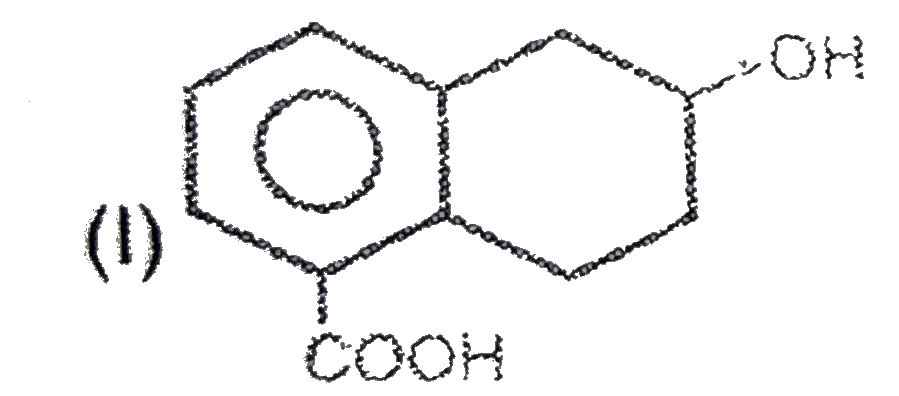Compounds I and II can be distinguished by using reagent.
I II4-Amino-2methylbut-3-en-2ol4-Amino-2,2-dimethylbut-3-yn-1-ol
NaNO2/HCl
Br2/H2O
HCl/ZnCl2 (anhydrous )
Cu2Cl2/NH4OH
The correct Answer is:C
To distinguish between the two compounds, 4-Amino-2-methylbut-3-en-2-ol (Compound I) and 4-Amino-2,2-dimethylbut-3-yn-1-ol (Compound II), we can use specific reagents that react differently with primary and tertiary alcohols.
1. Identify the Structure of Each Compound:
- Compound I (4-Amino-2-methylbut-3-en-2-ol):
- It has a hydroxyl (OH) group at the second carbon, a double bond at the third carbon, and an amino (NH2) group at the fourth carbon.
- This compound is classified as a tertiary alcohol because the carbon bearing the OH group is connected to three other carbon atoms.
- Compound II (4-Amino-2,2-dimethylbut-3-yn-1-ol):
- It has a hydroxyl (OH) group at the first carbon, a triple bond at the third carbon, and an amino (NH2) group at the fourth carbon.
- This compound is classified as a primary alcohol because the carbon bearing the OH group is connected to only one other carbon atom.
2. Choose the Reagent for Distinction:
- We can use Lucas Reagent, which consists of concentrated hydrochloric acid (HCl) and anhydrous zinc chloride (ZnCl2). This reagent is effective in differentiating between primary and tertiary alcohols.
3. Perform the Reaction:
- When Lucas Reagent is added to Compound I (tertiary alcohol), it will react immediately, resulting in the formation of an alkyl chloride and producing turbidity (cloudiness).
- When Lucas Reagent is added to Compound II (primary alcohol), there will be no immediate reaction, and thus no turbidity will be observed.
4. Conclusion:
- By observing the reaction with Lucas Reagent, we can distinguish between the two compounds:
- Turbidity indicates Compound I (tertiary alcohol).
- No turbidity indicates Compound II (primary alcohol).
Final Answer:
The two compounds can be distinguished by using Lucas Reagent (HCl and ZnCl2).
---
- Compound I (4-Amino-2-methylbut-3-en-2-ol):
- It has a hydroxyl (OH) group at the second carbon, a double bond at the third carbon, and an amino (NH2) group at the fourth carbon.
- This compound is classified as a tertiary alcohol because the carbon bearing the OH group is connected to three other carbon atoms.
- It has a hydroxyl (OH) group at the first carbon, a triple bond at the third carbon, and an amino (NH2) group at the fourth carbon.
- This compound is classified as a primary alcohol because the carbon bearing the OH group is connected to only one other carbon atom.
- We can use Lucas Reagent, which consists of concentrated hydrochloric acid (HCl) and anhydrous zinc chloride (ZnCl2). This reagent is effective in differentiating between primary and tertiary alcohols.
- When Lucas Reagent is added to Compound I (tertiary alcohol), it will react immediately, resulting in the formation of an alkyl chloride and producing turbidity (cloudiness).
- When Lucas Reagent is added to Compound II (primary alcohol), there will be no immediate reaction, and thus no turbidity will be observed.
- By observing the reaction with Lucas Reagent, we can distinguish between the two compounds:
- Turbidity indicates Compound I (tertiary alcohol).
- No turbidity indicates Compound II (primary alcohol).
The two compounds can be distinguished by using Lucas Reagent (HCl and ZnCl2).
Topper's Solved these Questions
Similar Questions
Knowledge Check
- Question 1 - Select One
The best method to prepare 3-methylbutane-2-ol from 3-methylbut-1-ene is
Aaddition of water in presence of dil. H2SO4Baddition of HCl followed by reaction with dil. NaOHChydroboration -oxidation reactionDReimer-Tiemann reaction . - Question 2 - Select One
The compounds butan-1-ol and 2-methylpropan-1-ol are
Achain isomersBposition isomersCfunctional isomersDmetamers
The following two compounds I and II can be distinguished by using reagent
 " "
" " 
(a) aq. NaHCO3 " " (b) Neutral FeCl3
(c ) Blue litmus solution " " Na metal " " (e) HCl/ZnCl2 anhydrousView SolutionThe following two compounds I and II can be distinguished by using reagent

(a) aq. NaHCO3 , Neutral FeCl3
(b) Blue litmus solution , Na metal
(c) HCl/ZnCl2 anhydrousView SolutionThe following two compounds I and II can be distinguished by using reagent

(1)Aq.NaHCO3 , (2)Neutral FeCl3(aq.)(FeCl3+NH4OH+H2O)
(3)Blue litmus solution , (4)Na metal
(5)HCl+ZnCl2(anhydrous)View SolutionAcetaldehyde and Propyne can be distinguish by :
(i) Tollen's reagent " " (ii) l2/NaOH " " (iii) Lucas reagent " " (iv) neutral FeCl3View SolutionWrite the structure of 4, 4-dimethylpentan-2-ol.
View SolutionWrite down structure of the following compounds:
3-methylbut-3-en-1-olView Solution


